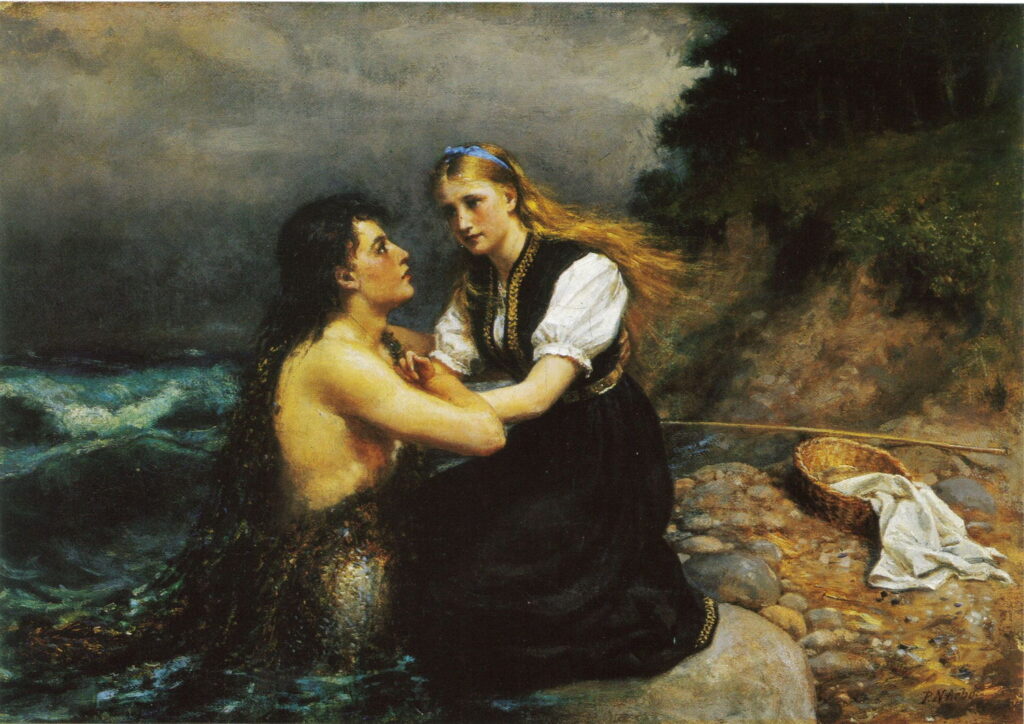Reading visual art: 170 Mermaid

Mermaids and mermen are mythical creatures with origins outside the classical Mediterranean civilisations. Conventionally, their upper body is human, while below the waist they have the form of a fish. Mermaids seem invariably young, beautiful and buxom, and are most frequently encountered by fishermen and those who go down to the sea. In the Middle Ages they became confounded with the sirens of Greek and Roman myth, who were part human and part bird.
John William Waterhouse (1849–1917), A Mermaid (1900), oil on canvas, 96.5 x 66.6 cm, Royal Academy of Arts, London. Wikimedia Commons.
John William Waterhouse’s diploma study for the Royal Academy, painted in 1900, shows a conventional image of A Mermaid, seen combing her long tresses on the shore.
Despite their separate origin, mermaids have been depicted in accounts of some classical myths, perpetuating medieval confusion.
Gustave Moreau (1826–1898), Venus Rising from the Sea (1866), oil on panel, 55.5 × 44.5 cm, Israel Museum מוזיאון ישראל, Jerusalem. Wikimedia Commons.
Gustave Moreau’s Venus Rising from the Sea from 1866 shows the goddess as she has just been born from the sea, and sits on a coastal rock, her arms outstretched in an almost messianic pose. On the left, a mermaid attendant holds up half an oyster shell with a single large pearl glinting in it. On the right, a merman proffers her a tree of bright pink coral, and cradles a large conch shell.
Ary Renan (1857–1900), Charybdis and Scylla (1894), oil on canvas, 89.5 x 130 cm, Musée de la Vie romantique, Paris. Wikimedia Commons.
Ary Renan’s Charybdis and Scylla (1894) is an imaginative painting of one of the dangers to mariners in the Strait of Messina, between Sicily and the Italian mainland. Scylla was said to be a six-headed sea monster, but was actually a rock shoal, and Charybdis was a whirlpool. Renan shows both together, the whirlpool with its mountainous standing waves at the left, and the rocks at the right, with the form of a beautiful mermaid embedded in them.
Franz von Stuck (1863–1928), A Faun and a Mermaid (1918), oil on canvas, 156.7 × 61.5 cm, Private collection (also a copy in Alte Nationalgalerie, Berlin, Germany). Wikimedia Commons.
As the First World War was ending, Franz von Stuck returned to his favourite faun motif in A Faun and a Mermaid (1918). This has survived in two almost identical versions, the other now being in the Alte Nationalgalerie in Berlin. His version of a mermaid is a maritime equivalent of a faun, with separate scaly legs rather than the more conventional single fish tail. She grasps the faun’s horns and laughs with joy as the faun gives her a piggy-back out of the sea.
Perhaps the earliest painting of a mermaid in European art is in a Christian religious painting by Lucas Cranach the Elder, from 1518-20.
Lucas Cranach the Elder (1472–1553), Saint Christopher (1518-20), oil on lime, 41.9 × 7.9 cm, Detroit Institute of Arts, Detroit, MI. Wikimedia Commons.
Cranach’s Saint Christopher shows the saint with his back and legs flexed as he bears the infant Christ on his left shoulder. In the foreground is an unusual putto-mermaid with a long coiled fish tail.
Mermaids feature in folktales from many of the traditions of Europe, where they’re known by local names such as havfrue in Denmark.
John Reinhard Weguelin (1849–1927), The Mermaid of Zennor (1900), watercolour, dimensions and location not known. Wikimedia Commons.
John Reinhard Weguelin’s watercolour of The Mermaid of Zennor (1900) tells the legend of a mermaid living in a cove near Zennor in Cornwall. This scene brings her together with Matthew Trewhella, a local chorister, whose voice she had fallen in love with. The legend tells that the couple went to live in the sea, and that his voice can still be heard in the cove.
Peter Nicolai Arbo (1831–1892), Liden Gunver and the Merman (1874-1880), oil on canvas, 26.5 x 37 cm, Private collection. Wikimedia Commons.
Peter Nicolai Arbo’s Liden Gunver and the Merman (1874-1880) is drawn from an opera The Fishers, by Johannes Ewald and Johann Hartmann, first performed in Copenhagen in 1780. The young woman Liden Gunver, on the right, is taken to sea by the alluring but deceptive merman on the left.
Hans Thoma (1839–1924), Three Mermaids (1879), oil on canvas, 106 × 77.6 cm, Städelsches Kunstinstitut und Städtische Galerie, Frankfurt, Germany. Wikimedia Commons.
Hans Thoma’s Three Mermaids (1879) lack fishtails as they frolic raucously with fish under the light of the moon.
Gustav Klimt (1862–1918), Mermaids (Silverfish) (c 1899), oil on canvas, 82 x 52 cm, Private collection. Wikimedia Commons.
Gustav Klimt’s Mermaids (Silverfish) (c 1899) appear to be tadpole-like creatures with smiling, womanly faces.



